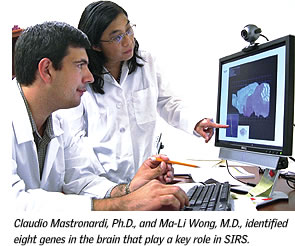 Intensive care units can be dangerous places
for patients. In addition to the causes that led them to the
ICU, some patients develop a dangerous inflammation that can
quickly spread throughout their body. Systemic inflammatory
response syndrome (SIRS) claims as many as 200,000 American
lives each year. Intensive care units can be dangerous places
for patients. In addition to the causes that led them to the
ICU, some patients develop a dangerous inflammation that can
quickly spread throughout their body. Systemic inflammatory
response syndrome (SIRS) claims as many as 200,000 American
lives each year.
Some of the cases are triggered by a known infection,
but others remain something of a mystery.
Miller School of Medicine researchers have clearly
identified, for the first time, how the brain modulates the
inflammatory
response in SIRS, the tenth leading cause of death in intensive
care units. Their study, published in April in the Proceedings
of the National Academy of Sciences, identified eight genes
that play a role inside the brain in triggering SIRS.
“It has never been this clear that the brain is an important
site of regulation of this inflammatory response,” says
Ma-Li Wong, M.D., professor and vice chair for translational
research
in the Department of Psychiatry and Behavioral Sciences at the
Miller School.
SIRS is closely related to sepsis, a system-wide
infection. Sepsis, known for alterations in body temperature
and white blood cell
count and a racing heartbeat, is triggered by an infection.
SIRS is similar but without any sign of infection, so its cause
was
never well understood. This study clearly identifies activities
in the brain that are relevant to SIRS.
“A lot of diseases of the brain have inflammation as a
common mediator, including stroke, Alzheimer’s disease,
and SIRS,” says
Julio Licinio, M.D., professor and chairman of the Department
of Psychiatry and Behavioral Sciences. “So what we show
in this paper is that an enzyme, caspase 1, plays a very important
role in this inflammatory response.”
“We describe the specific pathways that play a role in
inflammation, and they may also play a role in some neuropsychiatric
disorders,” says
Claudio Mastronardi, Ph.D., a specialist in pharmacogenomics
at the Miller School and the lead author on the article. |